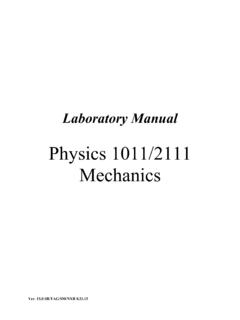Transcription of AW: Table 1 CAS: Table 2 RTECS: Table 2
1 ELEMENTS by ICP (Microwave Digestion) 7302. AW: Table 1 CAS: Table 2 RTECS: Table 2. METHOD: 7302, Issue 1 EVALUATION: FULL Issue 1: 21 July 2014. OSHA: Table 2 PROPERTIES: Table 1. NIOSH: Table 2. Other OELs: [1,2]. ELEMENTS: aluminum cadmium lead phosphorus strontium yttrium antimony calcium lithium platinum tellurium zinc arsenic chromium magnesium potassium thallium zirconium barium cobalt manganese selenium tin beryllium copper molybdenum silver titanium boron iron nickel sodium vanadium SAMPLING MEASUREMENT. SAMPLER: FILTER (mixed cellulose ester membrane (MCE), TECHNIQUE: INDUCTIVELY COUPLED ARGON PLASMA, 37-mm diameter, m pore size) ATOMIC EMISSION SPECTROSCOPY.
2 (ICP-AES). FLOW RATE: 1 to 4 L/min ANALYTE: Elements listed above VOL-MIN: -MAX: Table 1 REAGENTS: mL of 1:1 nitric (HNO3) and ASTM Type II. water SHIPMENT: Routine FINAL. SAMPLE SOLUTION: 20% HNO3, 25 mL. STABILITY: Stable WAVELENGTH: Depends upon element (see Table 3). BLANKS: 2 to 10 field blanks per set BACKGROUND. ACCURACY CORRECTION: Spectral wavelength shift RANGE STUDIED: See Table 4 CALIBRATION: Elements in 20% HNO3. ACCURACY: See Table 4 RANGE: See Table 4. BIAS: See Table 4 ESTIMATED LOD: Table 3. OVERALL PRECISION ( Sr ) : Table 3. S rT ): PRECISION ( See Table 4. APPLICABILITY: This method is for the analysis of metal and nonmetal dust collected on MCE filters in the workplace.
3 The working range varies from element to element. The method entails simultaneous elemental analysis using a microwave diges- tion approach to simplify and expedite the analysis. INTERFERENCES: Spectral interferences are the primary interferences encountered in ICP-AES analysis. These are minimized by judicious wavelength selection, inter-element correction factors and background correction [3]. OTHER METHODS: This method complements NIOSH hotplate digestion methods 7300 and 7301 for trace elements. Flame atomic absorption spectroscopy ( , Methods 7013 through 7082) is an alternative analytical technique for many of these elements [4]. Graphite furnace AAS ( , 7102 for Be, 7105 for Pb) is usually more sensitive [4].
4 NMAM 7301 and 7303 contain alternative extraction procedures. NIOSH Manual of Analytical Methods (NMAM), Fifth Edition ELEMENTS by ICP (Microwave Digestion): METHOD 7302, Issue 1, dated 21 July 2014 - Page 2 of 9. REAGENTS: EQUIPMENT: 1. Nitric acid, conc., trace metal grade* 1. Sampler: mixed cellulose ester membrane (MCE). 2. Calibration stock solutions, 1000 g/mL filter, m pore size, 37-mm diameter; in and 10,000 g/mL commercially available, 2-piece cassette filter holder or prepared per instrument manufacturer's 2. Personal sampling pump, 1 to 4 L/min, with recommendation (see step10) flexible connecting tubing 3. Digestion acid*. 1:1 water, ASTM type II, and 3.
5 Inductively coupled plasma-atomic emission nitric acid*, trace metal grade spectrometer, equipped as specified by the 4. Argon, liquid manufacturer for analysis of elements of interest 5. De-ionized Water, ASTM Type ll [5] 4. Regulator, two-stage for argon 6. Dilution acid*, 20% nitric acid in ASTM Type II 5. Microwave, programmable power, active water temperature control, minimum of 574 W, corrosion resistant ventilated oven and * See Special Precautions turntable 6. Microwave digestion vessels, high pressure, closed PTFE, 100-mL capacity 7. Volumetric flasks, 25 mL**. 8. Assorted volumetric pipettes as needed**. ** Acid wash all glassware and vessels before using.
6 SPECIAL PRECAUTIONS: Wear gloves, lab coat, and safety glasses while handling all chemicals. All work should be performed with adequate ventilation to personnel and equipment. Because this method involves the use of capped digestion containers, avoid the use of other acids such as perchloric acid in combination with nitric acid that could cause a violent reaction [6,7]. In the preparation of the digestion and dilution acids, it is imperative that acid be added to water in order to avoid a violent exothermic reaction. SAMPLING. 1. Calibrate each personal sampling pump with a representative sampler connected to the pump (in line). 2. Sample at an accurately known flow rate between 1 and 4 L/min.
7 For estimated sampling volumes see Table 1. For TWA measurements see Table 2. Do not exceed a filter loading of approximately 2 mg total dust. NOTE: Filter overloading can be assessed by periodic visual checks. See NMAM guidance chapters for discussion on sampling. SAMPLE PREPARATION. NOTE: If total weights are desired, weighing should be done at this step. Follow NIOSH method 0500. for gravimetric analysis [11]. 3. Open the cassette filter holders and transfer the samples, blanks, and Quality Control (QC) filters to clean PTFE digestion vessels. Wipe the internal cassette surfaces with a 37-mm MCE filter, polyvinyl alcohol wipe or cellulosic wipe wetted with deionized water, and add to the digestion vessel to transfer non-filter aerosol deposits into the digestion vessels.
8 4. Add digestion acid up to 10 mL, and cap the vessels. NIOSH Manual of Analytical Methods (NMAM), Fifth Edition ELEMENTS by ICP (Microwave Digestion): METHOD 7302, Issue 1, dated 21 July 2014 - Page 3 of 9. NOTE: In order to avoid a violent exothermic reaction, do not add water to concentrated nitric acid. Acid should be added after the water has been placed in the vessel. 5. Place digestion vessels in microwave, and run the preprogrammed digestion procedure for 12- vessel digestion: 1200 W power, ramp to 150 C over 20 min, hold for 10 min at 150 C followed by at least a 5. min cool down (power will be adjusted lower for fewer vessels). 6. Allow the samples to cool to room temperature.
9 7. Remove vessel lids and rinse contents into 25-ml volumetric flasks with ASTM Type ll water. 8. Dilute to the mark with ASTM Type ll water and mix. 9. Submit extracted and diluted samples for analysis. CALIBRATION AND QUALITY CONTROL. 10. Calibrate the spectrometer according to the manufacturer recommendations. NOTE: Typically an acid blank and multi-element working standards are used. The following multi- element combinations are chemically compatible in 20% HNO3. a. Al, As, Ba, Be, Ca, Co, Cr, Cu, Fe, Li, Mg, Mn, Mo, Na, Ni, Pb, Se, Sr, Ti, V, Y, Zn, Zr;. b. B, K, P, Sn, Te, Tl;. c. Ag, Cd, Sb;. d. Pt. 11. Analyze all applicable standards at least once every twenty (20) analyses (minimum frequency 5%).
10 12. Check recoveries with at least one media blank and two spiked media blanks per twenty samples. Use a spike level that is within the range of 10 to 20 times the LOQ. NOTE: Whenever possible, QA/QC samples should be prepared from certified reference materials in a matrix similar to the bulk material sampled. Liquid spiked filters are only surrogates for real world samples and QC data based upon certified samples are preferred. MEASUREMENT. 13. Set ICP-AES spectrometer to conditions specified by manufacturer. 14. Analyze standards and samples at applicable wavelengths for each element (target analytes are in Table 3). NOTE: If the values for the samples are above the linear range of the instrument, dilute the solutions with dilution acid, reanalyze, and apply the appropriate dilution factor in calculations.

















